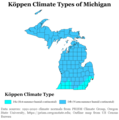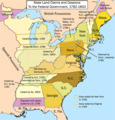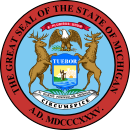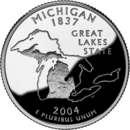Portal:Michigan
The Michigan Portal  Michigan (/ˈmɪʃɪɡən/ MISH-ig-ən) is a state in the Great Lakes region of the Upper Midwest region of the United States. It borders Wisconsin to the northwest in the Upper Peninsula, and Indiana and Ohio to the south in the Lower Peninsula; it is also connected by Lakes Superior, Michigan, Huron, and Erie to Minnesota and Illinois, and the Canadian province of Ontario. With a population of nearly 10.12 million and an area of 96,716 sq mi (250,490 km2), Michigan is the 10th-largest state by population, the 11th-largest by area, and the largest by area east of the Mississippi River. Its capital is Lansing, and its largest city is Detroit. Metro Detroit is among the nation's most populous and largest metropolitan economies. The name derives from a gallicized variant of the original Ojibwe word ᒥᓯᑲᒥ (mishigami), meaning "large water" or "large lake". Michigan consists of two peninsulas. The Lower Peninsula resembles the shape of a mitten, and comprises a majority of the state's land area. The Upper Peninsula (often called "the U.P.") is separated from the Lower Peninsula by the Straits of Mackinac, a five-mile (8 km) channel that joins Lake Huron to Lake Michigan. The Mackinac Bridge connects the peninsulas. Michigan has the longest freshwater coastline of any political subdivision in the United States, being bordered by four of the five Great Lakes and Lake St. Clair. It also has 64,980 inland lakes and ponds. Michigan has the second-most water area of any state, behind only Alaska. The area was first occupied by a succession of Native American tribes over thousands of years. In the 17th century, French explorers claimed it as part of the New France colony, when it was largely inhabited by Indigenous peoples. French and Canadian traders and settlers, Métis, and others migrated to the area, settling largely along the waterways. After France's defeat in the French and Indian War in 1762, the region came under British rule. Britain ceded the territory to the newly independent United States after its defeat in the American Revolutionary War. The area was part of the larger Northwest Territory until 1800, when western Michigan became part of the Indiana Territory. Michigan Territory was formed in 1805, but some of the northern border with Canada was not agreed upon until after the War of 1812. Michigan was admitted into the Union in 1837 as the 26th state, a free one. It soon became an important center of industry and trade in the Great Lakes region, attracting immigrants in the late 19th and early 20th centuries from many European countries. Immigrants from Finland, Macedonia, and the Netherlands were especially numerous. Migration from Appalachia and of Black Southerners as part of the Great Migration increased in the 1930s, with many settling in Metro Detroit. Although Michigan has developed a diverse economy, in the early 20th century it became widely known as the center of the U.S. automotive industry, which developed as a major national economic force. It is home to the country's three major automobile companies (whose headquarters are all in Metro Detroit). Once exploited for logging and mining, today the sparsely populated Upper Peninsula is important for tourism because of its abundance of natural resources. The Lower Peninsula is a center of manufacturing, forestry, agriculture, services, and high-tech industry. (Full article...) Entries here consist of Good and Featured articles, which meet a core set of high editorial standards.
 The Michigan Wolverines men's basketball team is the intercollegiate men's basketball program representing the University of Michigan. The school competes in the Big Ten Conference in Division I of the National Collegiate Athletic Association (NCAA). The Wolverines play their home games at the Crisler Center in Ann Arbor, Michigan. Michigan has won one NCAA Championship as well as two National Invitation Tournaments (NIT), 15 Big Ten Conference titles and two Big Ten tournament titles. In addition, it has won an NIT title and a Big Ten tournament that were vacated due to NCAA sanctions. Michigan has had 35 All-Americans, selected 48 times. Eight of these have been consensus All-Americans, which are Cazzie Russell (twice), Rickey Green, Gary Grant, Chris Webber, Trey Burke, as well as Harry Kipke, Richard Doyle and Bennie Oosterbaan (twice) who were retroactively selected by the Helms Foundation. Twelve All-Americans have been at least two-time honorees. Russell was the only three-time All-American. (Full article...)Selected picture - Campus Martius Park is a re-established park in downtown Detroit, Michigan. After the fire of 1805, Campus Martius (from the Latin for Field of Mars, where Roman heroes walked) was the focal point of judge Augustus Woodward's plans to rebuild the city. Did you know -
Related portalsSelected article -Traverse City (/ˈtrævərs/ TRAV-ərs) is a city in the U.S. state of Michigan. It is the county seat of Grand Traverse County, although a small portion extends into Leelanau County. The population was 15,678 at the 2020 census, with 153,448 residents in the four-county Traverse City metropolitan area. Traverse City is the most populous city in the Northern Michigan region. Traverse City is located at the head of the East and West arms of Grand Traverse Bay, a 32-mile-long (51 km) bay of Lake Michigan. Grand Traverse Bay is divided into arms by the 17-mile-long (27 km) Old Mission Peninsula, which is attached at its base to Traverse City. The city borders four townships–East Bay, Elmwood, Garfield, and Peninsula–all of which contain substantial suburban sprawl. (Full article...)Selected biography -Henry Benjamin Greenberg (January 1, 1911 – September 4, 1986), nicknamed "Hammerin' Hank", "Hankus Pankus", and "the Hebrew Hammer", was an American professional baseball player and team executive. He played in Major League Baseball (MLB), primarily for the Detroit Tigers as a first baseman in the 1930s and 1940s. A member of the Baseball Hall of Fame and a two-time Most Valuable Player (MVP) Award winner, he was one of the premier power hitters of his generation and is widely considered one of the greatest sluggers in baseball history. Greenberg played the first twelve of his 13 major league seasons for Detroit; with the Tigers, he was an All-Star for four seasons and was named the American League (AL) Most Valuable Player in 1935 and 1940. He had a batting average over .300 in eight seasons, and won two World Series championships with the Tigers (1935 and 1945). He was the AL home run leader four times and his 58 home runs for the Tigers in 1938 equaled Jimmie Foxx's 1932 mark for the most in one season by anyone other than Babe Ruth, and tied Foxx for the most home runs between Ruth's record 60 in 1927 and Roger Maris' record 61 in 1961. Greenberg was the first major league player to hit 25 or more home runs in a season in each league, and remains the AL record-holder for most runs batted in in a single season by a right-handed batter. (Full article...)General imagesThe following are images from various Michigan-related articles on Wikipedia.
TopicsCategoriesSymbols
Lists
Related pagesWikimediaThe following Wikimedia Foundation sister projects provide more on this subject:
Things you can doDiscover Wikipedia using portals | ||||||||||||||||||||||||||||||||||||










































































